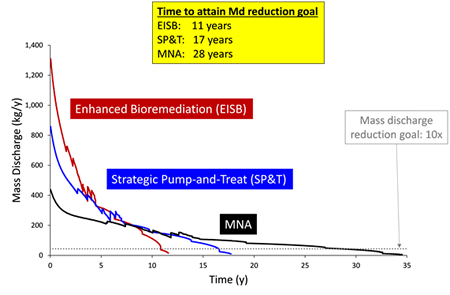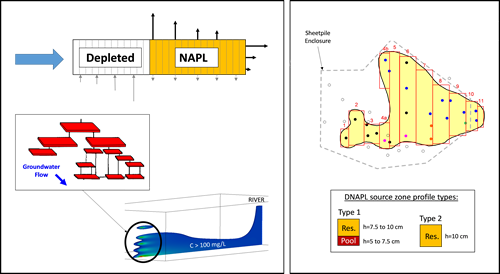
| SOFTWARE |

The NAPL Depletion Model (NDM) is a semi-analytical screening model which may be used to estimate NAPL depletion under conditions of naturally-occurring or enhanced dissolution. NDM is used to predict mass discharge versus time for a wide range of source conditions. NDM is public domain software, and may be downloaded for FREE using the link below. NDM is programmed in Fortran. Any text editor may be used to prepare the input files, and Microsoft Excel or similar software is used to review the model output files.

Uses of NDM may include:
- Interpretation of NAPL architecture based on calibration of a model to historical discharge trends;
- Estimation of future mass discharge decline rates and depletion timeframes for an existing alternative;
- Evaluation of the relative performance of various potential alternatives as part of feasibility study;
- Quantifying the relative sensitivity of predicted trends (e.g. depletion timeframe) to various site characteristics, in order to identify those characteristics which require further investigation.
NDM is used primarily to estimate relative timeframes for NAPL source zone natural attenuation (MNA), and enhanced dissolution technologies such as EISB (i.e. bioremediation), ISCO, or strategic pump-and-treat which involves enhanced flushing within the source zone.
NDM works with two types of source zones: (a) where distinct layers of residual or free phase NAPL sub-zones are characterized to occur; or (b) a mixed zone where individual NAPL layers or sub-zones cannot be distinguished.

NDM may be used as a process-oriented model, which means that it explicitly represents various porous media and NAPL characteristics which influence the rate of dissolution for one or more NAPL sub-zones within an overall source zone. A sub-zone refers to a NAPL body (e.g. layer) which is relatively continuous, and may not be further discretized into smaller sub-zones on the basis of geometry, porous media characteristics, and/or NAPL characteristics (e.g. chemical composition, NAPL saturation, or density). A NAPL source zone in NDM is comprised of one or more individual sub-zones.
NDM may also be used in a more simple fashion when the NAPL architecture is unknown, as an up-scaled model that represents domain-averaged mass discharge decline rates for a “mixed” source zone.
NDM may be used for LNAPL or DNAPL, and was developed with the flexibility to simulate NAPL pools, residual NAPL layers, and/or mixed zones of NAPL. NDM simulates two types of dissolution or discharge processes for each simulated sub-zone: (a) surface dissolution at the top or bottom of a sub-zone; and (b) reduced groundwater flow through a sub-zone based on a user-specified or model-calculated relative water permeability. A future version will also facilitate simulation of mass flux into or out of lower-permeability zones adjacent to one or more NAPL sub-zones.
The key output variables for NDM are the mass discharge and NAPL mass remaining for each individual sub-zone, and the total metrics for the combined source zone. NDM does not simulate changes in aqueous concentrations outside of the NAPL sub-zones, although it is possible to use simple multipliers to simulate or calibrate the ratios of daughter product formation for mass discharge calculations.